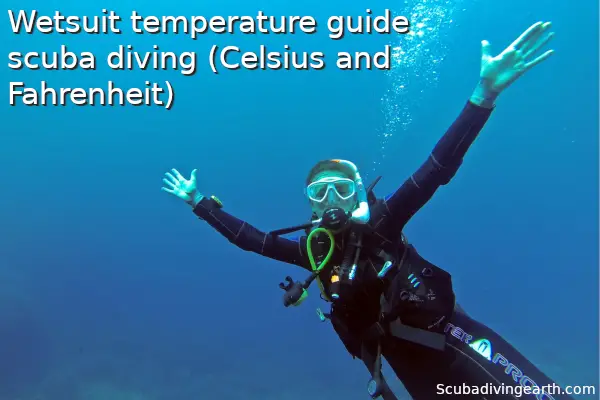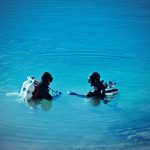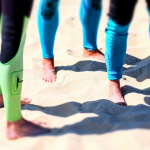
A wetsuit water temperature guide in Celsius and Fahrenheit
When scuba diving, the colder the water temperature the thicker the wetsuit is needed to keep warm. But how cold the water is and how thick the wetsuit needs to be is also affected by by your personal tolerance to the cold.
Wetsuit temperature guide scuba diving for those prone to feel the cold:
- 29°C (84°F) – 1-2mm wetsuit (shorty would be ok).
- 26-28°C (79-82°F) – Full length 1-2mm wetsuit.
- 22-25°C (72-77°F) – Full length 3-5mm wetsuit.
- 18-21°C (64-70°F) – Full length 5-7mm wetsuit or semi-drysuit.
- 10-17°C (50-63°F) – Definitely a drysuit.
- Less than 10°C (50°F) – Drysuit with high tog under-suit.
The best way to do more diving in your wetsuit is to book yourself on a scuba diving liveaboard. You can check the latest and best deals on liveaboards using the following window:
When you consider any guide to choose a wetsuit vs water temperature, you must consider your own personal tolerance to the cold. Below is a table of water temperatures that includes exposure suits for those who don’t feel the cold.
In addition to how easily you feel the cold, also consider the topside conditions between dives on your dive interval. But also take account of the depth of your dive too.
There are many factors that will affect how warm or cold you feel on a dive. But always remember that water sucks heat out of your body 25 times faster than air of the same temperature.
For example, in the UK room temperature tends to be around 21°C (57°F) and feels comfortable. However, swimming in water at this same temperature, without at the very least wearing a wetsuit, would feel quite cold in contrast.
Therefore, the colder the water, the more insulation you need to protect you from heat loss. The exposure suit you wear will keep you comfortable on your dive and prevent hypothermia.
In colder waters, and especially if you “feel the cold” you may wish to consider a semi drysuit or even switch to a drysuit to dive instead of using a wetsuit.
More Reading: What is the difference between a wetsuit and a dry suit?
Do your homework before you travel to your scuba diving destination
Before you embark on your scuba travels, always do your homework about your destination’s water temperature. Make sure to consider thermoclines where you’re diving.
For example, I have dived in the Red Sea many times, which is very warm. But often times dived deep and below 30 metres (98 feet), and entered a cold patch of water and been glad of my wetsuit!
More Reading: What is the difference between a drysuit and a semi dry suit?
You want to be comfortable when you’re scuba diving. But it’s not only about comfort, as you’ll breathe more air if you are cold, as your body tries to keep its temperature.
More Reading: 28 Tips on How to Conserve Air While Scuba Diving (How To Extend Your Dive Time Safely)

Number of dives will affect your choice of wetsuit vs drysuit
The type of exposure suit you wear will also be affect by the diving itself. The number of dives you make on a day and how cold the air temperature is will have an impact. Also, bear in mind if you’re likely to experience rain, as cold wet weather will impact on how cold you get in between dives.
If you don’t get chance to warm up on your dive interval, you will be cold on your next dive. But also, if it’s not so warm when you’re on the dive boat, when you next put your ‘wet’ wetsuit back on this isn’t nice!
More Reading: Do You Wear Anything Under A Wetsuit? (What To Wear Male & Female)
How deep you dive will affect your choice of wetsuit vs drysuit
How deep you dive will impact on which exposure suit you wear. The deeper you go, the colder the water will be. So even if the water temperature may be say 26°C (79°F) on the surface, by the time you reach your dive depth, the water temperature may have drop several degrees.
More Reading: What Is Deep Diving For Scuba Divers? (26 Tips For Deep Scuba Diving)
Let’s now look at a table of water temperatures and wetsuit thicknesses for scuba diving. This water temperature table also includes the temperature at which a semi-drysuit or a drysuit may be more appropriate too.
| Water Temperature | Scuba Divers Not Prone to Cold Water | Scuba Divers Prone to Cold Water |
|---|---|---|
| >29°C (84°F) | Skin Dive or Lycra/Polartec suit | 1-2mm wetsuit (shorty would be ok) |
| 26-28°C (79-82°F) | 1-2mm shorty wetsuit possibly skin dive or with Lycra/Polartec suit | Full length 1-2mm wetsuit |
| 22-25°C (72-77°F) | Full length 2-3mm wetsuit or possibly a shorty | Full length 3-5mm wetsuit |
| 18-21°C (64-70°F) | Full length 3-5mm wetsuit | Full length 5-7mm wetsuit or semi-drysuit (or even a drysuit) |
| 10-17°C (50-63°F) | Full length 7-8mm wetsuit or preferably a drysuit | Definitely a drysuit! |
| Less than 10°C (50°F) | Drysuit | Drysuit but make sure to wear a high tog under-suit... Or choose a warmer destination! |
How cold can you dive in a wetsuit?
How cold you can dive in a wetsuit is affect by many factors. The first one is down to your own personal tolerance to the cold.
If you are someone who ‘feels the cold‘ go by the second of the two columns in the above table.
In addition to your personal body thermometer, the wetsuit thickness equation also task account of your gender, your age, your health and how fit your body is, your body fat, your metabolism and your personal comfort level.
Another factor that not many know about when it comes to “feeling the cold” is cancer treatment. I went through chemotherapy to cure cancer and now I feel the cold more than I did before I had cancer.
So if you’ve gone through cancer treatment and get back to diving, you may find you need to up your exposure suit accordingly.
I’d have put myself in the first column in the above table before cancer treatment, whereas now I’m in the second column.
Skin diving without a wetsuit
In the above table in warmer waters above 29°C (84°F) where your tolerance to cold water is high I’d still recommend in a Rash Guard made from Lycra or Polartec.
This is to prevent any rubbing from your scuba equipment, but it will also provide protection from the sun burn and stinger from fire coral or jellyfish.
You may like to read about how to clean a smelly wetsuit, which includes the smell of urine. There are some important do’s and don’ts’s of cleaning a wetsuit to make sure it lasts.
I hope you enjoyed this article about wetsuit temperature guide scuba Celsius
I’d love to hear from you. Tell us about your adventures of diving and snorkeling, in the comments below. Please also share your photos. Either from your underwater cameras or videos from your waterproof go-pro’s!
If this article hasn’t answered all of your questions. If you have more questions either about snorkeling or scuba diving (or specifically about wetsuit temperature guide scuba Celsius & Fahrenheit), please comment below with your questions.
There will also be many more articles about scuba and scuba diving safety tips (and on snorkeling too) for you to read and learn about this fabulous sport.
Have fun and be safe!



